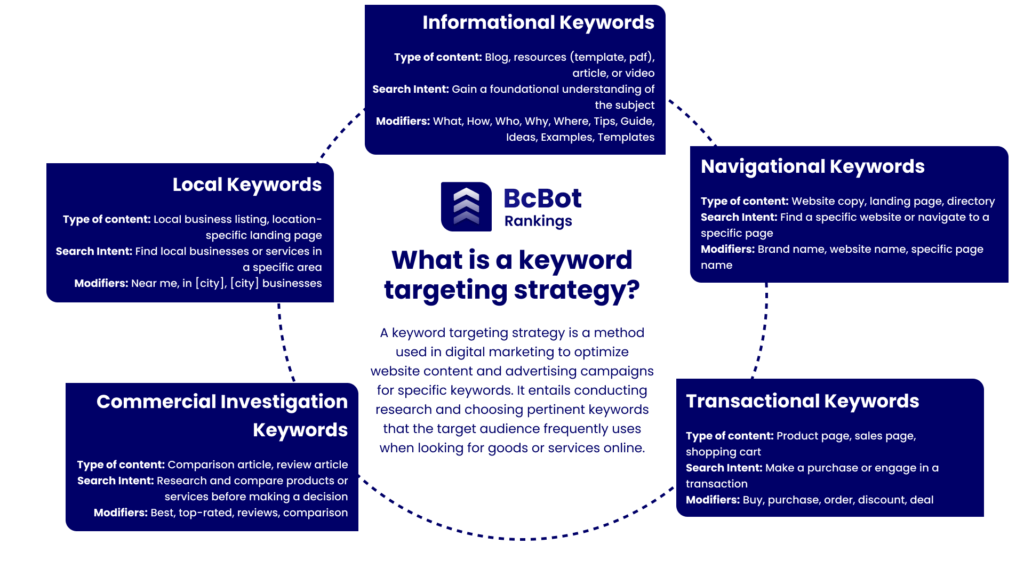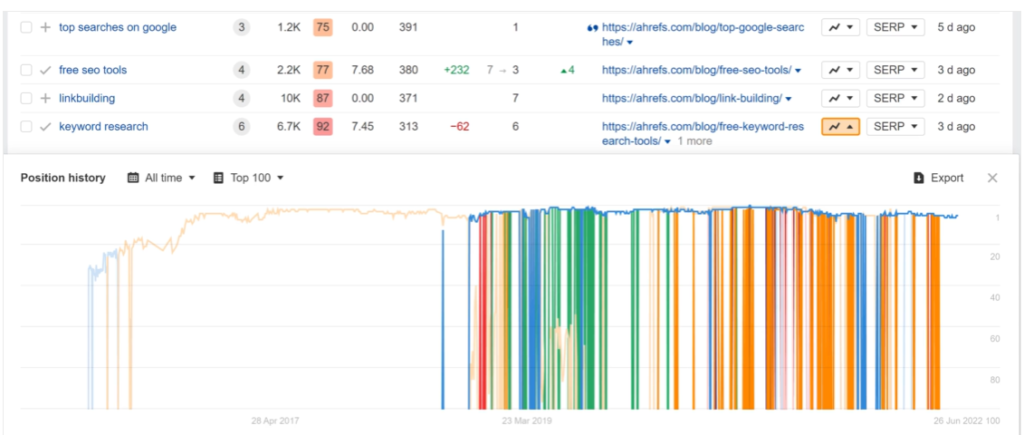Keyword research is an essential step in any SEO strategy. It enables you to tailor your content to your target audience’s purpose by assisting you in understanding their search queries. However, if you don’t have a methodical technique in place, undertaking keyword research can turn into a time-consuming effort. That’s where a keyword research checklist can come in handy.
Using a checklist can help you cover all the bases and take advantage of all vital opportunities while conducting keyword research. Here’s a keyword research checklist template that you can use to streamline your keyword research process and maximize your SEO efforts:
Otherwise, let’s go through the step-by-step checklist to guide you through the keyword research process.
Define your goals and objectives
Start by determining what you want to achieve with your keyword research. Ask yourself these questions:
- Are you looking to increase organic traffic, improve rankings, or target specific audiences?
- Are you aiming to generate more leads, increase sales, or enhance brand awareness?
- How will you use your keyword research insights to make data-driven decisions?
You can maximize the influence of your keyword research approach on your overall strategy by defining your goals and objectives and then tailoring your approach accordingly.
Identify your target audience
Understand your target audience and the things they are researching. This will assist you in producing worthwhile and pertinent material that aligns with search intent. Here’s how you can identify your audience:
- Conduct market research to gather information about your target audience’s demographics, interests, and behaviors.
- Use social media and website analytics to understand the preferences and habits of your existing audience.
- Use keyword research tools to identify the search queries relevant to your business and align with your target audience’s interests.
- Analyze competitor websites and their audience engagement to gain insights into their target audience and potential opportunities for targeting.
- Create buyer personas based on the collected data, including age, gender, interests, and motivations, to better understand and connect with your target audience.
These methods can help you better understand the requirements and preferences of your target audience. As a result, you can produce content that appeals to them, increasing engagement and conversions and your chances of accomplishing your objectives in general.
Brainstorm seed keywords
Seed keywords are the core of keyword research and are primary concepts or themes pertinent to your company or sector. They act as a springboard for finding relevant keywords and learning what your target market is looking for.
List some introductory keywords that are associated with your company or sector. These might be general words that will function as an outline for further research. For instance, if you are a fitness influencer and you are targeting people who are interested in losing weight, some possible seed keywords include “weight loss tips,” “healthy diet,” and “exercise routines.”
Brainstorming these initial keywords can help you identify more niche and long-tail keywords relevant to your target audience, such as “low-carb meal plans” or “HIIT workouts for beginners.”.
Expand your keyword list
Use keyword research tools like Ahrefs, Keywords Everywhere, and Google Keyword Planner for more suggestions. Search for low-competition, high-search volume long-tail keywords and their variants.

During your brainstorming session, these tools help you find keywords you overlooked. You can also learn a lot about what is successful in your sector by researching the keywords used by your rivals. You may find fresh keyword opportunities and better grasp the industry by determining which keywords they target.
As time goes on and search trends and patterns shift, remember to update and improve your keyword list periodically.
Analyze keyword metrics
Using the keyword research tools listed above, determine each keyword’s search volume, degree of competition, and prospective traffic value.

You can use this to prioritize the terms you should concentrate on. Remember that choosing which keywords to target shouldn’t be based only on keyword metrics.
Even while search volume and level of competition are significant measures of term value, your target audience and specific goals may not always coincide with them. So, consider the significance and intention of every term to guarantee that it corresponds with your content and company goals.
You can track keyword performance and make changes based on real-time data to improve your search strategy further. Keyword research is a continuous activity that you must continuously monitor and improve upon to stay ahead of the competition and drive relevant traffic to your website.
Consider user intent
Analyze each keyword’s purpose by reviewing the search results and determining what people try to find when using it. You can better match user expectations with your content by doing this. When analyzing user intent, the context in which people are looking for information about your company should be considered. Do they want product comparisons, in-depth information, or particular solutions?

You can customize your material to better suit the demands of your target audience by knowing the meaning behind each term. This might involve writing instructive how-to manuals, in-depth product descriptions, or educational blog entries.
When you match your content to your customer’s expectations, you offer helpful information that draws visitors to your website, keeps them interested, and motivates them to do desired actions, like buying something or completing a form.
Analyze competitor keywords
Examine the keywords your competitors focus on and secure high rankings for in search results. This might help you identify holes in your approach or prospective possibilities. You can use various tools and methods to conduct competitor keyword analysis.
One strategy is to find the terms your rivals rank for using keyword research tools like Ahrefs or SEMrush.

These tools offer helpful information on similar terms, search traffic, and keyword difficulty.
Through a thorough analysis of your rivals’ keyword strategy, you might find holes in your keyword targeting or potentially neglected terms. You can also examine how your rivals use these keywords in their content by looking at the content of their websites.
Organize keywords into categories or themes
Group related keywords together based on their relevance and similarity. This will help you structure your content strategy and create targeted pages or blog posts. You can organize your keywords into the following categories:
- Informational keywords: users are seeking information or answers to their questions. These keywords often include phrases like “how to,” “what is,” or “tips for.”
- Navigational keywords: users are looking for a specific website or brand. These keywords usually include the company’s name or website they are searching for.
- Commercial keywords: users are in the research phase of their buying journey and may include terms like “best,” “top-rated,” or “reviews.”
- Investigation keywords: users are actively comparing different options and may include terms like “vs.,” “compare,” or “alternatives.”
- Transactional keywords: users are ready to purchase and may include phrases like “buy now,” “discount code,” or “free shipping.”
You can more fully comprehend the meaning behind each keyword and adjust your content by grouping your keywords into these categories.
Prioritize keywords based on opportunity and relevance
Prioritize your keywords according to their potential and relevance to your business once you have classified them and determined their intent. This will enable you to focus on the keywords that will yield the most significant returns and efficiently deploy your efforts.
Finding high search volume keywords is an excellent place to start since it suggests a wider potential audience. Additionally, search for low-competition keywords because ranking and getting seen for them will be more straightforward.
Ensure your selected keywords closely correspond with your target market and company objectives. This will guarantee that your efforts are focused on drawing in the proper type of visitors and possible clients.
Monitor and optimize
Monitor your selected keywords’ performance regularly for conversions, traffic, and rankings. Make the required changes to your SEO strategy to keep your competitive edge. This entails evaluating the effectiveness of the keywords used by your rivals and seeing any potential fresh prospects.

Additionally, you may retain your search engine ranks and draw in a consistent flow of organic visitors by regularly updating and optimizing your content with pertinent keywords. By staying proactive and adaptable in your SEO efforts, you can ensure long-term success for your business.
Final Thoughts
A comprehensive keyword research checklist is essential to any effective digital marketing plan. It helps you find your company’s most pertinent and practical keywords and ensures you take all crucial steps.
You can save time and money by organizing your keyword research with the help of the appropriate template. So, include this checklist in your marketing strategy and observe as your website’s visibility and organic traffic increase dramatically.

